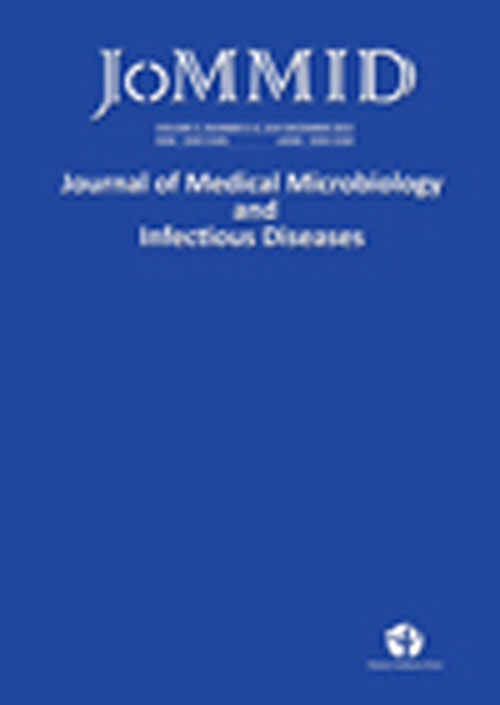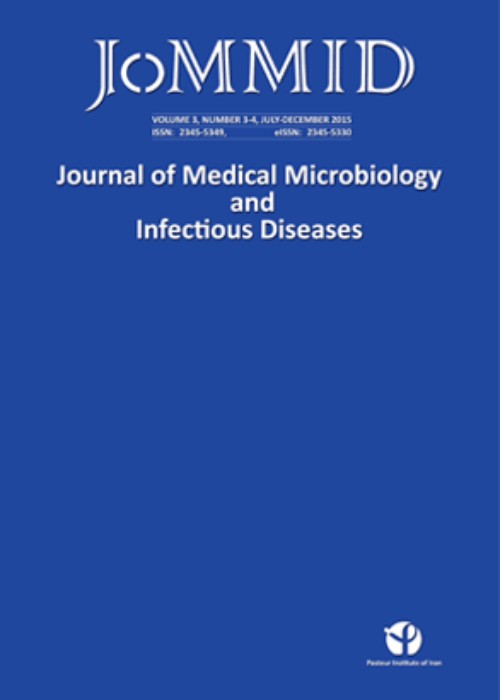فهرست مطالب

Journal of Medical Microbiology and Infectious Diseases
Volume:5 Issue: 3, Summer-Autumn 2017
- تاریخ انتشار: 1396/10/30
- تعداد عناوین: 8
-
-
Detection of Brucella spp. in the Sheep and Goats Milks from Southeastern Iran Using Culture and PCRPages 40-42IntroductionBrucellosis is a zoonotic disease caused by the members of the genus Brucella. This bacterium is transmitted to humans through exposure to infected animals or via consumption of contaminated dairy products. Cultivation of the bacteria or amplification of its DNA using polymerase chain reaction (PCR) are conventional diagnostic approaches for definitive identification of Brucella in raw milk.MethodWe collected 530 milk samples from 485 healthy animals, and 45 animals with a history of abortion from Kerman province, southeast Iran. The specimens were first cultured in Eugon broth and then were subcultured on Brucella agar. Gram smears from colonies for characterization of the bacteria were prepared. Also, DNA extraction and PCR amplification of IS711 fragment were performed to detect Brucella DNA in the milk samples.ResultsThe culture method detected Brucella Spp. in 10 milk samples including two samples from apparently healthy animals (1 sheep sample, and 1 goat sample) as well as eight samples from animals with abortion history (6 sheep samples, and 2 goat samples). PCR identified Brucella DNA in 43 samples including those from healthy sheep (n=4) and goats (n=9), as well as animals milk with abortion history (7 sheep, and 23 goats). The proportion of positive samples detected by PCR method was significantly higher than culture method (P=0.014).ConclusionThe PCR assay turned to be a convenient method for detection of Brucella contamination of raw milk and can be used as a reliable tool for surveillance and screening of contaminated milk.Keywords: Brucella, PCR, Culture, Goat, Sheep
-
Pages 43-46IntroductionCysticercus fasciolaris is the larval stage of the cestode Taenia taeniaeformis, whose definitive hosts are cats. Rodents and very rarely humans act as intermediate hosts. Here, we investigated the rate of infection among urban rats in the north of Khuzestan province, southwest of Iran, and described the histopathological changes in the liver of infected animals.MethodsOne hundred eight rats were collected from the cities Dezful, Sush, and Andimeshk in the north of Khuzestan province during 2014-2015. The rats were sacrificed, dissected, and their livers were removed and examined macroscopically for the presence of the cyst, which were then cut open and inspected for larvae. The cysts of infected livers were examined for the histopathological changes and the recovered larvae were identified based on morphometric features.ResultsOut of 108 rats examined, 8 (7.4%) had small to moderate size cysts. Each cyst had two layers and contained one larva of C. fasciolaris. The scolex of the larvae had four suckers and a rostellum armed with two rows of hooks. The infected livers had multiple cysts and liver parenchyma necrosis or neoplastic evidence were not seen in the tissue sections.ConclusionThe small size cysts indicated actue infection, which may explain the absence of sarcoma as well.Keywords: Cysticercus fasciolaris, Rats, Histopathological changes
-
Pages 47-50IntroductionThe strains of Pseudomonas aeruginosa are known as an opportunistic pathogen that can cause infections in humans and animals. Metallo-β-lactamases (MBLs) are the most significant factors of resistance to carbapenem antibiotics in these bacteria. This study was designed to identify the MBLs producing P. aeruginosa isolates in three hospitals of Tehran, Iran.MethodsTotally, we obtained 665 samples from patients hospitalized in three hospitals in Tehran, Iran. Antibiotic-susceptibility test of the P. aeruginosa isolates was done based on Kirby-Bauer disk diffusion test. The Minimum Inhibitory Concentration (MIC) of the isolates was performed using agar dilution method, and IPM-EDTA test identified MBL producing isolates.ResultsAmong the examined isolates, 473 (71.1%) were P. aeruginosa. Among these, 306 (64.7%) were resistant to imipenem, and 289 (94.5%) were MBL producers. Furthermore, the resistance rate of the isolates to other antibiotics was amikacin (26%), tobramycin (24.95%), ceftazidime (23.05%), gentamicin (22.83%), carbenicillin (21.14%), and ceftizoxime (18.19%). The MICs of imipenem and ceftazidime for the majority of the isolates were 4 µg/ml and ˃128 µg/ml, respectively.ConclusionThis study confirmed previous reports on the increased rate of MBL-mediated resistance in P. aeruginosa isolates worldwide. Therefore, detection of resistance patterns for these isolates, particularly MBLs, is necessary for prevention and control of Pseudomonas associated infections.Keywords: Pseudomonas aeruginosa, Metallo, β, lactamase, IPM, EDTA, MIC
-
Pages 51-55IntroductionDental caries is a significant public health problem which destroys the calcified tissues of the teeth. The frequency of lactobacilli in dental caries is usually high. The objective of this study was to evaluate the incidence of these bacteria in dental caries and to identify the antibiotic resistance patterns of them.MethodsSpecimens from dental plaque were collected from 30 patients. Phenotypic (Gram staining, cell morphology, and biochemical tests) and molecular (PCR) methods were used for identification of Lactobacillus bacteria. The antimicrobial sensitivity test was performed by standard Kirby-Bauer disk diffusion method to determine their resistance to chloramphenicol, penicillin, vancomycin, nitrofurantoin, cefixime, cefazolin, amoxicillin-clavulanic acid, and tetracycline. Antibiotic resistance genes were detected using multiplex PCR method as well.ResultsFourteen out of 30 (46/6%) samples were Lactobacillus positive. The mecA was the essential gene responsible for penicillin resistance. Also, the blaTEM and blaOXA-1 genes had more significant role in cefazolin and cefixime resistance than blaSHV, and these two genes had the similar role in the amoxicillin-clavulanic acid resistance. Also, tetracycline resistance was caused by both tetK and tetM genes identically.ConclusionIn conclusion, Lactobacillus bacteria had an essential role in the formation of dental plaque and showed multidrug-resistant patterns to commonly used antibiotics.Keywords: Dental plaque, Lactobacillus, Multiplex PCR, resistance genes
-
Pages 56-61IntroductionIn Iran, 95% of animal bites are attributed to domestic dogs and cats, while one-third of rabies victims are from wildlife. The wolf is one of the primary vectors of wildlife in the country. This study was aimed to assess the impact of wildlife on rabies transmission and to evaluate the efficacy of an oral rabies vaccine (ORV) in the gray wolf (Canis lupus pallipes).MethodsWe studied the incidence of wolf attacks by analyzing a 10-year period of data (2000 to 2009) available in the Ministry of Health and Medical Education, the Veterinary Organization and Pasteur Institute of Iran. In the next step, five captive gray wolves were fed by Raboral V-RG® vaccine baits (Merial®, part of Boehringer Ingelheim, Germany) and monitored for rabies neutralizing antibodies over 20 months by rapid fluorescent focus inhibition test (RFFIT).ResultsOur analysis showed that 55% of animal bites occurred in rural areas and the remaining in urban areas. The most rabid wolves were from Fars province in southern Iran. The vaccine baits were palatable for the hungry wolves. Seroconversion with antibodies titers ≥0.5 IU/ml occurred after 12 weeks and maintained for 78 weeks indicating potential protection against rabies after receiving a single ORV bait.ConclusionOur results suggested that a single dose of vaccination with V-RG®, though initially designed for foxes and raccoons, can protect the gray wolf against rabies as well.Keywords: Oral rabies vaccination (ORV), Rabies, anti, rabies antibodies, wolf
-
Pages 62-65IntroductionSpondylitis is a serious disease caused by a variety of pathogens. The identification of spondylitis etiologies is a very important medical issue. This study was conducted to compare clinical, laboratory and radiological features of the patients with tuberculous (TS), brucellar (BS) and pyogenic spondylitis (PS) in a central city of Iran.MethodsIn this retrospective study, we obtained the data of 100 patients with spondylitis from a hospital in Arak city. The patients were divided into three groups including TS (8 cases), BS (71 cases) and PS (21 cases), based on the spondylitis etiology.ResultsThe mean age of cases with TS, BS, and PS was 67.25±20.26, 55.39±15.60 and 52.19±12.74 years, respectively. The most common clinical feature was back pain followed by fever. Twenty-one cases had psoas abscess which was more common in PS group. No significant difference regarding the involved vertebral regions was observed between the groups. Intravenous drug use, history of vertebral surgery and chronic renal failure were frequent in patients with PS, and all TS cases had pulmonary involvement.ConclusionOur data showed that presence of concomitant pulmonary involvement and a confirmed history of tuberculosis are suggestive of tuberculous spondylitis. However, the distinction between TS and BS is still problematic and only a combination of clinical data, laboratory findings, radiological features and history of TB can be helpful in differentiation of TS and BS.Keywords: Spondylitis, Brucellosis, Tuberculosis, Pyogenic
-
Pages 66-68Ticks harbor many pathogenic, as well as endosymbiotic and non-pathogenic agents. They are host of a variety of as yet unidentified microbes that continue to be described. In the present study, a Brucella-like bacterium was detected in a Boophilus tick by PCR amplification of a partial fragment of 16S rRNA locus followed sequencing. Our results show that the members of the genus Boophilus may act as vectors of brucellosis in nature, but further studies are required to confirm the real role of ticks as vector or reservoirs of specific Brucella species.Keywords: 16S rRNA, phylogenetic tree, Brucellaceae, Boophilus
-
Pages 69-70To the editor: In a recent publication entitle Surveillance of Crimean-Congo haemorrhagic fever in Pakistan published in The Lancet Infectious Diseases, the authors claimed that before the Eid al-Adha, Crimean-Congo Hemorrhagic Fever (CCHF)-livestock infected are imported from Iran and Afghanistan to Baluchistan province of Pakistan and then transferred to other areas of the countryKeywords: Crimean, Congo Haemorrhagic Fever, Pakistan


